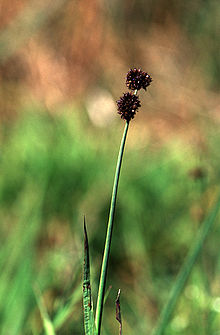
Juncaceae is a family of flowering plants, commonly known as the rush family. It consists of 8 genera and about 464 known species of slow-growing, rhizomatous, herbaceous monocotyledonous plants that may superficially resemble grasses and sedges. They often grow on infertile soils in a wide range of moisture conditions. The best-known and largest genus is Juncus. Most of the Juncus species grow exclusively in wetland habitats. A few rushes, such as Juncus bufonius are annuals, but most are perennials.

Silene flos-cuculi, commonly called ragged-robin, is a perennial herbaceous plant in the family Caryophyllaceae. This species is native to Europe and Asia, where it is found along roads and in wet meadows and pastures. In Britain it has declined in numbers because of modern farming techniques and draining of wet-lands and is no longer common. However, it has become naturalized in parts of the northern United States and eastern Canada.

Thlaspi caerulescens, the Alpine Penny-cress or alpine pennygrass, is a flowering plant in the family Brassicaceae. It is found in Scandinavia and Europe.

Juncus acutus, the spiny rush, sharp rush or sharp-pointed rush, is a flowering plant in the monocot family Juncaceae.

Juncus articulatus is a flowering plant species in the rush family Juncaceae. It is known by the common name jointleaf rush or jointed rush, which can also refer to J. kraussii from Australia. It is native to Eurasia, Canada, Greenland, and much of the United States. It grows in moist areas, such as wet sand, and thrives in calcareous soils. J. articulatus was found to be more sensitive to drought and salt stress than its congeners J. acutus and J. maritimus. It is a perennial herb producing mainly erect stems from a short rhizome. The stem may root at nodes, and it generally has one or more flattened hollow cylindrical leaves up to 10 centimeters long. Transverse internal partitions or joints may be seen or felt in the leaf of the plant.
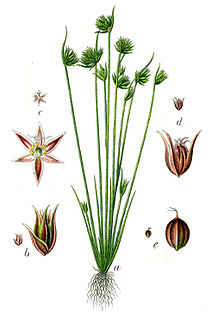
Juncus capitatus is a species of rush known by the common names dwarf rush and leafybract dwarf rush. It is native to Europe, Asia and North Africa. It is also an introduced species in parts of North America such as California and the Gulf Coast. It grows in moist areas, such as wet sand, vernal pools, and ditches.

Juncus mertensianus is a species of rush known by the common name Mertens' rush or Alaska rush. It is native to much of western North America from Alaska to Saskatchewan to New Mexico, where it grows in wet mountainous areas such as riverbanks and alpine meadows. This is a clumping perennial herb growing from a vertical rhizome. Its smooth, flat stems grow to a maximum height near 40 centimeters. Its few leaves are located at the base and also along the stem. The inflorescence is made up of usually one cluster of many flowers. Each flower has shiny dark brown to black tepals 3 to 4 millimeters long, six stamens with yellowish anthers, and long reddish stigmas, as in image at left. The fruit is a dark, oblong capsule, as in image at right.
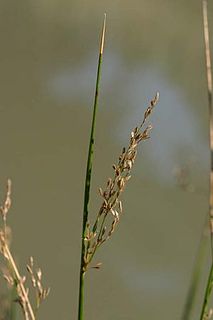
Juncus mexicanus is a species of rush known by the common name Mexican rush. It is native to the southwestern quadrant of the United States and parts of Mexico and Central and South America. It is a plant of moist areas in a great number of habitats, from coast to desert to mountain and low to high elevation.
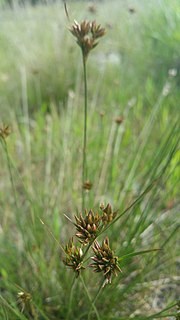
Juncus occidentalis is a species of rush known by the common name western rush. It is native to the western United States, where it grows in wet areas in many types of habitat. This is a bunching perennial herb with thin, stiff stems reaching maximum heights between 30 and 60 centimeters. The wispy leaves grow from the base of the stem and may approach half the stem's length. The inflorescence holds loose bundles of individual flowers and there is usually one long, leaflike bract extending far past the flowers. Each flower has green-striped brownish to reddish tepals each several millimeters long, and six stamens with small anthers. The fruit is a brown capsule which grows encased within the tepals.

Juncus patens is a species of rush, known by the common names spreading rush and California grey rush.

Juncus dubius is a species of rush known by the common name wrinkled rush. It is endemic to California, in the California Coast Ranges, Transverse Ranges, and southern Sierra Nevada. It is a common member of the flora in many wet areas, such as marshes and riverbanks.
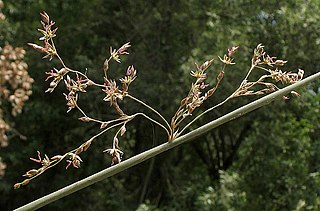
Juncus textilis is a species of rush known by the common name basket rush. It is endemic to California, where it grows along the coast and in the coastal mountain ranges of the southern half of the state.
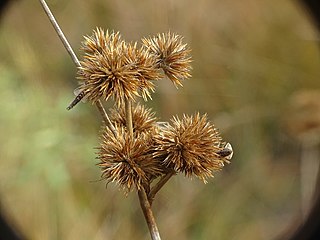
Juncus torreyi is a species of rush known by the common name Torrey's rush. It is native to North America, where it is widespread. It can be found in many habitats across the southern half of Canada, coast to coast in the United States, and throughout northern Mexico. This is a perennial herb growing from rhizomes with associated tiny tubers. The smooth stems vary in maximum height from 30 centimeters to around a meter. The leaves are green to pink or red and up to 30 centimeters long. The inflorescences have many dense, rounded clusters of up to 100 flowers each. The flower has narrow, pointed greenish, tan, or reddish tepals and six stamens. The fruit is a pointed brown capsule.
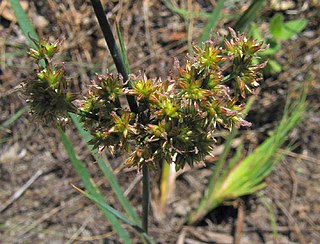
Juncus xiphioides is a species of rush known by the common name irisleaf rush.
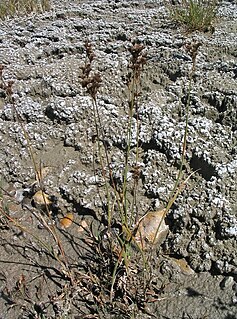
Juncus saximontanus is a species of rush known by the common name Rocky Mountain rush. It is native to much of western North America from Alaska to central Mexico, where it grows in wet habitat, often in mountainous areas, such as bogs and moist meadows.

Juncus kraussii commonly known as salt marsh rush, sea rush, jointed rush, matting rush or dune slack rush, is of the monocot family Juncaceae and genus Juncus. It grows in salt marshes, estuarine and coastal areas.

Hypericum pulchrum is a flowering plant in the family Hypericaceae, commonly known as slender St John's-wort. It is native to Western Europe.
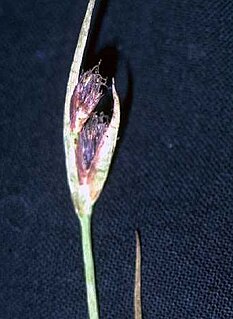
Juncus castaneus is a species of rush known by the common name chestnut rush. It has a circumboreal or circumpolar distribution, occurring throughout the northern latitudes of the Northern Hemisphere. It occurs in Europe, Asia, and North America. In North America it occurs from Alaska to Greenland, its distribution spanning Canada and extending south through the Rocky Mountains in the contiguous United States. It is widespread and common in the Canadian Arctic Archipelago.

Oreojuncus trifidus is a species of rush known by the common names highland rush and three-leaved rush. It is native to the Northern Hemisphere, where it is an arctic/montane species with an amphi-atlantic distribution.
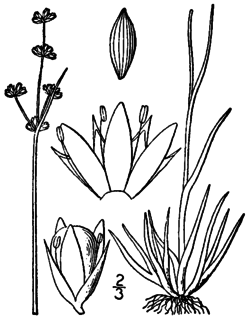
Juncus marginatus is a species of flowering plant, it is a type of rush with the common names of margined rush and grass-leaf rush.
